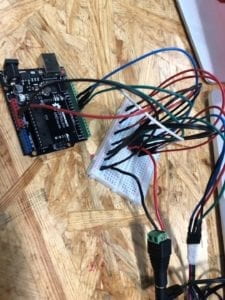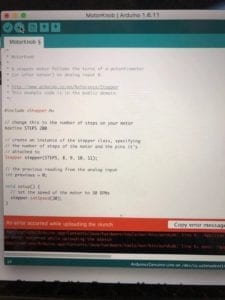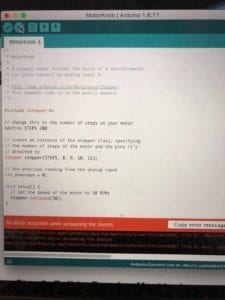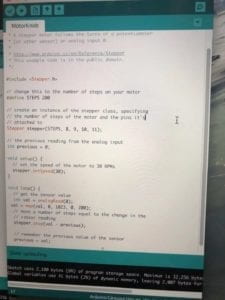Step 1:


This step involves building up the circuit, as well as opening the oneRevolution code from the example. For me, the only tricky thing during this process is to correctly connect the IC into the circuit. Also, the huge amount of wires require great patience, for it took me 10 to realize that I forgot to connect the ground on the breadboard with Arduino.
Step 2:

This step aims at realizing the control of the rotation of the stepper motor. The circuit is exactly the same as step one, but a few changes need to be done to the code. Firstly, we need to change the number of steps to 200 to fit the model of the stepper motor. We also need to add the map function to the code, so as to turn analogRead into analogWrite.
Step 3:

During this step, we need to cooperate with another person who has also come to this stage. We need to put together the arms of the drawing machine and connect our Arduino together. My partner and I each controlled one of the arms by rotating the knob and path of the pen reflect and depicts both our movements. Although it seems hard to draw anything vivid, the drawing machine is still very fun to play with!
Question 1:
For me, the kind of machine I want to build should be interactive and entertaining. My partner and I are thinking about making a maze of LEDs. By using the joysticks, users can control which led to light up. And for the maze part, they need to reach the endpoint from the start point by moving from one led to another on this path. What’s more, there will also be barriers that block some paths, meaning that not every path is available. The lighting box is also highly engaging, for my partner and I intend to design a competition, which is similar to the one we build during the second recitation. There will be two sets of LEDs on the surface of the box, and the one who gets to the end point first will have the buzzer buzzing. Therefore, this lighting maze box can be engaging and entertaining.
Question 2:
When reading the article, I find the art installation named “devolution” very interesting. I think the most striking similarity between this installation and the machine we built on class is that they are both extensions of the human body. While the drawing machine is an extension of human hands which estimates its function of painting, the installation called devolution estimates human feet and its function of dancing. What’s more, both these inventions attach great importance to the interactivity between human beings and the machine, trying to integrate machines into a part of our life. I guess those artists selected those specific actuators according to the needs of the circuits, for example, its function, the voltage, input, and output. But above all, the ideas and inspirations they have for these amazing inventions are very likely to be stem from real life.